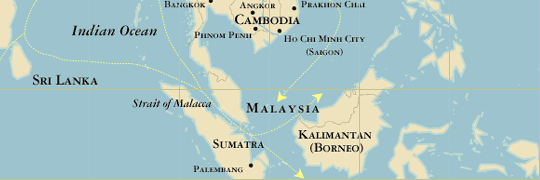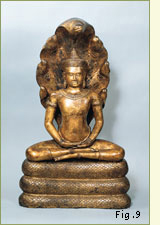|
|
|




   
Cambodia
The earliest historical records regarding Cambodia refer to a kingdom called Funan, which held dominion, from roughly the first or second century to the mid-seventh century, over the southern portion of present-day Cambodia and Vietnam, and also over parts of southern Thailand and possibly farther. Funan's wealth came from commerce, as is evidenced by the archeological finds of Indian gold jewelry, stones carved with Brahmi (an Indian script) characters, Roman coins and gold medallions, mirrors from the Chinese Han dynasty (ca. 206 B.C.E. – 220 C.E.), and goods from Iran and the Mediterranean, such as fragments of glassware. Buddhism was practiced in Cambodia by the sixth century at the latest, although Hinduism remained the country's dominant religion until roughly the twelfth century.  The earliest known Buddha images, which date from the sixth century, are linked to the Buddhist centers of southeastern India by such stylistic features as a low cranial bump (ushnisha) covered with large, flat, spiral curls. However, after the seventh century, there are no clear indications of Indian influence on Cambodian art, in contrast to the Buddhist art produced in the other regions of Southeast Asia, which was often influenced by various streams of Indian art. Unlike the region's most common representations of buddhas, which are unadorned, buddhas produced under the Khmer empire, which ruled Cambodia from the ninth to thirteenth centuy, were often crowned and bejeweled (Fig. 9). During the twelfth and thirteenth centuries, Khmer kings attempted to stress their close relationship to, if not their complete identification with, the Buddha. Thus, the crowns and jewelry adorning these images are similar to those worn by the earthly kings. The earliest known Buddha images, which date from the sixth century, are linked to the Buddhist centers of southeastern India by such stylistic features as a low cranial bump (ushnisha) covered with large, flat, spiral curls. However, after the seventh century, there are no clear indications of Indian influence on Cambodian art, in contrast to the Buddhist art produced in the other regions of Southeast Asia, which was often influenced by various streams of Indian art. Unlike the region's most common representations of buddhas, which are unadorned, buddhas produced under the Khmer empire, which ruled Cambodia from the ninth to thirteenth centuy, were often crowned and bejeweled (Fig. 9). During the twelfth and thirteenth centuries, Khmer kings attempted to stress their close relationship to, if not their complete identification with, the Buddha. Thus, the crowns and jewelry adorning these images are similar to those worn by the earthly kings.
Back
|
|
